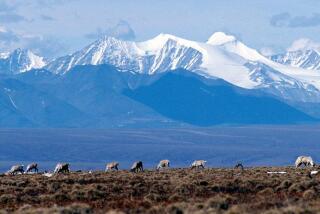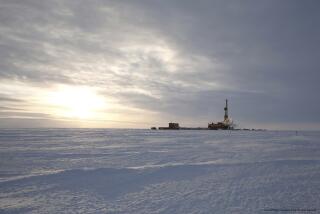A rafting trip into Alaska’s wild
ARCTIC NATIONAL WILDLIFE REFUGE, ALASKA — Arctic National Wildlife Refuge, Alaska
Dig! Pull! Harder, harder! Go! Go!,” chided leader Karen Jettmar.
She pushed us, five in each rubber boat, to reach down and grab a last thrust of energy that would drive the two bulky rafts ashore on Icy Reef, an exposed, narrow gravel bar. We were trying to cross the Kongakut River delta against the biting sting of a sleet-laced westerly that had blown in off the Beaufort Sea.
On its windward flank, the Beaufort roared with short, steep waves and flying spindrift. Temperatures were in the low 30s.
We were at the end of a 75-mile river adventure that had begun 11 days earlier in the warm upper reaches of the Kongakut Valley. But here the river was shallow; we had lost track of the main channel and were paddling in rivulets. We grounded, lifted the boats over sandbars, fell in, got wet; it was cold through every layer of Arctic wear.
Beached, we considered our prospects: Food was running low, and we were tired. Then someone asked to break out the goodies. “Forget the food; we’re in survival mode right now,” said Jettmar, who intimately knows this barren stretch of Arctic coastline.
Once ashore, we had to move rapidly. Tip the boats against the wind. Brace them with the paddles. Gather driftwood and start a fire. Huddle the tents together in the lee of the boats and double up on sleeping arrangements for warmth. Begin rationing drinking water.
Bush pilot Tom Shannon knew where we were, but he couldn’t necessarily get to us, even though Jettmar had a satellite phone to contact his dispatcher at our starting point of Kaktovik.
“He won’t fly in weather like this, so let’s just hunker down and hope for clearing,” she said. We tried not to worry about being socked in for days.
The day before this landing, we had ascended the 3,500-foot Dome at Caribou Pass, clearly having crossed an Arctic threshold from our 80-degree sunny days.
Facing north from the Dome’s talus-capped peak above dun-colored tundra, we witnessed a spectacular show below as the swirling fog, biting winds, rain and snow eventually opened up to reveal the shimmering ice pack far out on the blue Beaufort. Before us lay the verdant carpet of the Arctic plain, its lushness stitched together by the Kongakut delta.
We were four men and six women, unacquainted and geographically disparate when we met in Fairbanks, Alaska. During this trip late last summer, we had coalesced into a compatible and cooperative crew of willing adventurers on a journey with outfitter Equinox Wilderness Expeditions.
Jettmar, a veteran guide, author and advocate for preserving the Arctic National Wildlife Refuge, took the lead. Michael Engelhard, our second guide, splits his time between running rivers and backpacking in Alaska and rock climbing in the desert around Moab, Utah.
Stranded on Icy Reef, I wondered whether our fate would be like that of other lost explorers in the Arctic.
BUCKETS AND A BUNKHOUSEThe next afternoon, we heard the Cessna as it buzzed in out of the murk and dropped down onto the thin gravel bar. The pilot’s doughty craft had come to take us and our gear back to Kaktovik, an outpost in this 19 million acres of primitive bliss.
We had been greeted by cold rain and dense fog. No flights were heading to the river, so we tumbled into a van and dropped by the Waldo Arms Hotel. The hotel complex -- three joined double-wide trailers -- was a veritable minefield of buckets holding rainwater.
An incongruent and ever-changing troupe of hunters, local folks, river adventurers, writers and photographers climbed over one another and awaited burgers and fries at the adjacent kitchen gate. It was hot and close, and the hunters were steadily gazing at a blaring TV in the salon.
There was no room at the inn, which charges $175 per person for a double.
We were invited to check out the “bunkhouse,” a cold, damp, dank, sour, unheated and plumbing-free trailer. For $35, you got a bed -- a battered and stained mattress on a rusty frame.
Instead, we camped out on the beach. That night, a polar bear cruised by, crushed an aluminum pole of one of our tents and padded along to the whale boneyard on a spit near the airport.
There are two communities within the wildlife refuge: Kaktovik on the North Slope and Arctic Village, a Gwich’in Athabaskan community on the Chandalar River in the Brooks Range.
Kaktovik means the “seining place” in Inupiat. Nineteenth-century whaling crews named it Barter Island. It’s a historic Inupiat hunting and trading community of 280 on the Beaufort Sea that is divided over the issue of oil drilling within the refuge.
Robert Thompson, Inupiat hunter, guide, writer and defender of the refuge, keeps traditional ways close. The center of his living-room floor was covered with the fur of a musk ox, whose thick coat his wife, Jane, was currying into wool.
“This is the most weather-resistant natural fabric known to man,” Robert Thompson noted, as he got up to go fry another plate of fresh caribou.
After poking around Kaktovik, we left for the Kongakut Valley to start our trip.
Bucking head winds and downdrafts, the Cessna flew into the eerie valley of the Kongakut. Dark parapets drifted by, the mountains like castles crowned by raw stone battlements. Below, the winding river was pure aqua, the tundra was green and brown velveteen.
Shannon, our bush pilot, banked the Cessna into the river canyon and feathered us onto a tiny sandbar.
We quickly unloaded and began inflating the rafts, stowing the plastic canisters containing our provisions, getting our gear tucked into watertight river bags and lashing them atop the pile of canisters.
Under the tutelage of our guides, we immediately began to learn the procedures for paddling as teams, making sure to keep the bulky rafts on course through eddies, back flows and riffles.
“Right side back, left side forward! All back! All forward! Dig in with your torso and pull, pull, pull!”
We marveled at rock formations sculpted with faces, gargoyles, tiered pagodas and silver waterfalls.
Sharp-edged peaks of gray and black granite serve as a counterpoint to a consistent palette of dun, green, ocher and brown. The river, an aqua braid weaving among slate sandbars, was a lifeline -- a link to where we had been and, like a languid dream, a pathway to where we expected to be going. Everywhere, there was silence.
The mountains, stern and towering sentinels, were reminders of one’s minuscule presence here. And this vast and sometimes austere landscape engendered a newfound sense of awareness.
TUNDRA PROWLEagle-eyed Engelhard could see animals long before anyone else in our party and kept a watchful eye for formidable and unpredictable grizzlies. We saw Dall sheep on wide river bars; jaegers and eagles soared above. When we hiked across the tundra, we were greeted by Arctic ground squirrels, called sik sik by natives for their scolding tone.
One morning, I heard the whoop of a wolf nearby. We followed a well-pounded grizzly trail into the bush, dodging mosquitoes with the help of a breeze and DEET.
Our meals were hearty and tasty. Jettmar had mastered the art of bringing flavor and sustenance to the bush camp. Two of us fished and easily snared grayling and char, which went right into the frying pan. We picked tiny, sweet blueberries out of tundra tufts.
The rhythms of the Arctic summer were languid. We slept like angels in the pure, silent air. The cohesive paddling built muscles and good tidings. We’d had a taste of adventure in a land so big, so pure, so stunningly beautiful -- yet so formidable and changeable.
When it was time to go, we drew straws for a direct flight to Fairbanks. Some boarded a later plane to Prudhoe Bay, with a promised hookup to Fairbanks. The outside world was now very close, and it would be easy for the Kongakut Valley to be lost in a distant dream.
More to Read
Sign up for The Wild
We’ll help you find the best places to hike, bike and run, as well as the perfect silent spots for meditation and yoga.
You may occasionally receive promotional content from the Los Angeles Times.






